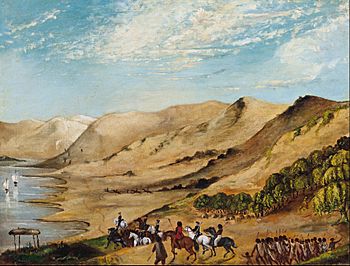Maria (1823 ship) facts for kids
Quick facts for kids History |
|
|---|---|
| Name | Maria |
| Builder | Grand Canal Docks, Dublin |
| Launched | 1823 |
| Out of service | 28 June 1840 |
| Fate | Wrecked, Margaret Brock Reef |
| General characteristics | |
| Type | Brigantine |
| Tons burthen | 135, or 136 (bm) |
| Length | 70.19 ft (21.4 m) |
| Beam | 20.99 ft (6.4 m) |
| Draught | 10.9 ft (3.3 m) |
| Sail plan | Brigantine |
| Armament | Single cannon |
| Notes | Passenger ship |
Maria was a brigantine, a type of sailing ship, built in Dublin, Ireland. She was launched in 1823 and used to carry passengers. On June 28, 1840, Maria was wrecked on the Margaret Brock Reef, near Cape Jaffa in South Australia. The exact location of the wreck has never been found. After the shipwreck, some of the survivors were tragically killed by Aboriginal people from the Coorong area as they tried to walk to Adelaide. This sad event is known as the Maria massacre.
Contents
History of the Maria
Building and Early Journeys
The ship Maria was built in 1823 at the Grand Canal Dock in Dublin, Ireland. She was a brigantine, which means she had two masts with a specific type of sails.
Records from Lloyd's Register, a book that tracks ships, show that Maria made several journeys. For example, in 1825, she sailed between Dublin and Barbados. Later, in 1830, she traveled between Liverpool and Gibraltar. The ship was repaired in 1827 and 1828. After 1835, Maria no longer appeared in Lloyd's Register. This might mean her ownership or registration moved to Australia.
The Final Voyage
On June 26, 1840, Maria left Port Adelaide in South Australia. She was heading for Hobart in Van Diemens Land (now Tasmania). There were 25 people on board, including the captain, William Ettrick Smith, and his wife. Other passengers included families with children and some crew members.
During the trip, Maria hit the Margaret Brock Reef. This reef is off the coast of South Australia, west of Cape Jaffa. Eight people died in the shipwreck. The remaining survivors managed to reach the coast. They landed somewhere near where the town of Kingston SE is today.
The Maria Massacre
After reaching land, the survivors of the Maria started walking along the Coorong coast. They were trying to reach the lakes, Lake Alexandrina and Lake Albert, hoping to find help. The sailors may have gone inland at some point, while most passengers stayed near the shore.
About 60 kilometers from the wreck site, the group reportedly met some friendly Aboriginal people. They found a track and disagreed about whether to follow it. They decided to split up. Captain Smith and the crew took the track, and most passengers continued along the shoreline. A couple of days later, some of the passenger group also split off, hoping to rejoin the captain.
Around this time, a group of the Milmenrura (also known as Tanganekald) attacked and killed some of the survivors. The Aboriginal people took their belongings. It is not known exactly how the survivors became separated into different groups, as no one from the Maria lived to tell the full story. The captain's body was found far from the others, and the crew members were never found. So, it's unclear if they faced the same fate as the passengers.
In 2003, Ngarrindjeri elder Tom Trevorrow shared that his elders knew the story well. He said that the Ngarrindjeri group offered the survivors "fire, water and food." It was their custom to help people. However, when they reached a boundary line, they had to hand the survivors over to the next family group, the Milmendura. At some point after this, a violent conflict happened, and all the Maria survivors were killed.
After the massacre, Governor Gawler ordered a group to find those responsible. This group carried out actions that were later found to be against the law.
After the Wreck
The main part of the Maria ship was never found. However, pieces of the wreckage washed ashore at Lacepede Bay. In 1972, a diver found a rubber part that might have come from either the Maria or another ship called the Margaret Brock. There have been stories about gold coins being on the ship, but this has not been confirmed by records. Some stories suggest that Aboriginal people traded coins, which they might have received from the survivors before the massacre.
People hope that the wreck of the Maria might be found one day using modern technology. Finding it would be very important for understanding this historical event. Experts believe the wreck is likely near Cape Jaffa, where the dangerous Margaret Brock reef is located.
A cannon, believed to be from the Maria, was bought by the Lee family of Middleton around 1914. It was used as a garden decoration and fired to welcome each New Year. A bell, also said to be from the ship, was acquired by Nuriootpa High School in 1942.
A special plaque remembering the wreck of Maria was put up at Kingston SE on February 18, 1966. Maria Creek was also named after the ship to remember the tragic event.
See also
- List of shipwrecks of Australia
- Rufus River massacre


